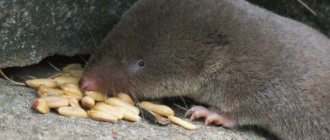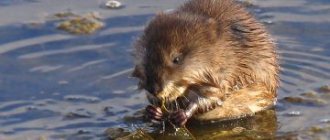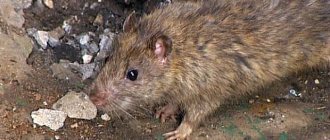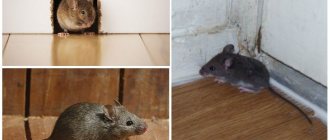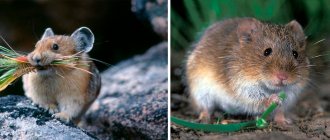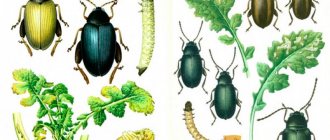- November 26, 2018
- Hunting
- Ekaterina Gordeeva
The farmer went out into the garden in the morning and grabbed his head. All the crops are turned inside out, there are strange holes around them. And the roots are gnawed.
Who did it? The first thought is that the moles tried. These diggers had nothing to do with it, because the river rats came to visit. If there is a body of water nearby, it’s definitely their business.
We'll talk about these animals in more detail in the article.
Who are you?
What kind of animal is a water rat? A pest that farmers and gardeners really dislike. Not only does the cute creature cause damage by damaging seedlings, but it also robs the beds.
River rats are the closest relatives of wild pasyuki. They have extreme gluttony and reproduce quickly. What does the animal look like? More on this below.
Tricks in the fight against water voles
Many gardeners try to expel water rats from their territory by inserting a hose into the discovered underground passages, the other end of which is connected to the exhaust pipe of the car. An idling engine fills the passages with harmful exhaust gases. The method does not always work if the underground labyrinths are highly branched and intricate.
Some gardeners scare voles with loud noises. To do this, plastic bottles with holes made in them need to be buried at an angle in the soil. The wind that gets inside will be transformed into a mournful whistle that rats cannot stand.
Special ultrasonic rodent repellers sold in stores are effective. The operation of these devices requires a constant power source or regular battery changes. It is also recommended to change the sound range to avoid animals getting used to it.
Interesting materials for expelling water voles that are sensitive to unpleasant odors are:
- Rabbit skin. It can be cut into several pieces, stuffed into burrows and set on fire.
- Furnace soot. Diluted with water to a viscous consistency, it is recommended to pour it into holes.
If the above methods are ineffective, you will have to use chemicals that need to be placed in the holes or near them. It is recommended to repeat this action after 5-7 days. Chemicals pose a direct danger to pets, so there should be no beloved pets in the area where they are used.
Description
The word “rat” makes some people cringe. If you look closely, both common and river rats are not so nasty. The latter are not particularly large comrades. They weigh about 250 grams. Their sizes vary from 20 to 25 centimeters.
They look like a pig and a guinea pig at the same time. A sort of strange hybrid: the snout of an underwater rat is short and rectangular, like that of a guinea pig, and the body of a rat is long, flexible, with a thin tail. By the way, the tail is covered with hairs and does not cause such disgust as a bald rat.
The water rat has long and thick fur. The upper part of the body (head, neck and back) is brown-gray. This is where the name came from - water rat. It seems that the color is ugly, but it is not. The photo shows that the animal is quite cute and its color scheme is in order.
The chest and belly of the animals are lighter than the main color.
Description and features of the rodent
The underwater rat (lat. Arvicola amphibius) is a rodent from the vole family that lives over a large area. Belongs to small mammals of the order of rodents, which are ancient and extremely common animals. Rodents inhabited our planet back in the distant times of the Cretaceous period. Since then, the appearance of the rodent has undergone changes; the animals have adapted well to changes in the external environment. In our country there are 11 families of the rodent order.
A river rat is a small mammal. The animal has brown or black fur on its back and bright fur on its belly. The tail is hooked and slightly hairy, the ears, nose and eyes are small. The length of the body with head is 13-25 cm, tail size: 6-15 cm.
Depending on the habitat, the weight and body size of the animal may differ. The average weight is 130-350 grams.
The main characteristics that describe the appearance of a water rat:
- massive and clumsy body; the third toe is longer than the others, the paws look like flippers; lack of hair on the back heels; the length of the tail is half the length of the body; there are no ring scales on the tail, the hair is sparse; at the tip of the tail there is a brush measuring 0.5 cm;color varies from red to black and depends on living conditions, but does not change depending on the season;fur is soft and fluffy;on the belly the color of the fur is usually lighter;small eyes are black;paws are poorly visible due to long hair ;number of teeth – 16 units.
Characteristic behavioral features of water rats:
- the step length is longer than that of ordinary voles, 7-8 cm; they are aquatic animals that move well and quickly in water; they swim quite long distances; they get food under water; on land they move as quickly as ordinary voles; method communication with each other: squeak; life expectancy: 3-4 years.
Where did you come to us from?
What is the name of the water rat and where does it live? We will answer the first part of the question a little later. We will talk about the place of residence of the beast in this subsection.
You can find a surprise in the form of a pest everywhere. The rodent is distributed throughout Russia.
In the warm season, the animal lives calmly in various bodies of water. A pond, a river, a lake—it’s all his family. It can even live in swamps.
With the onset of cold weather, river rats begin to think about a hole. In order to create it, they move to the meadows, where they dig a nest for wintering. “Old pensioners” don’t like to move. They build houses for themselves right in the swamp hummocks or next to their native pond. Is there a dead tree nearby? Rodents are happy and happy. They will make a mink, bring herbs there and spend the winter there.
Distribution and habitats of water rats
European water voles are distributed throughout most of Europe, Russia, Western Asia and Kazakhstan. Isolated populations are also found in parts of Canada and North America. However, they appear to survive poorly in more extreme environments, such as the highlands of northern Scotland or the hotter areas of southern France.
The water rat prefers the banks of slow-flowing rivers, lakes, ponds, damp meadows, etc., covered with bushes and trees, and in summer, floating islands on lakes.
Favorite places for settlement are relatively high, up to 1-2 meters high, banks, along which areas of meadow alternate with willow and reed clumps. Less commonly, the rodent makes its burrows in steep, steep banks devoid of vegetation.
In addition, in many places the water rat inhabits vegetable gardens, orchards and melon fields located along river valleys.
This vole rises to the mountains up to 2000 m above sea level. Here it sticks to creeks and places with relatively weak currents in mountain rivers.
Do you want to eat?
What is the official name of the river rat? A little patience, we'll tell you soon.
Let's talk about rodent nutrition for now. What does the animal that lives in and near water bodies eat?
Sedge, reeds, and reed shoots are the main diet of the water rat. They do not disdain marsh plants either. Of course, if they themselves live there.
Why do rats go to a person’s garden if they are provided with food? Rodents' favorite foods grow there. Aquatic comrades love root vegetables: potatoes, for example. Moreover, give them straight tubers, without rot or flaws. For the winter, reserves are made only from these.
They will happily eat beets and carrots. This is a favorite treat of river rats.
During the winter, supplies run out. So the animals have to go into human gardens. It would seem, what can you find there in the spring? People ate everything themselves. But don’t forget about the roots of garden plants. Water rats do not disdain them and eat them with great appetite.
Distribution of the water vole
The distribution area of the water vole covers the northern part of Eurasia from the Atlantic coast of Western Europe to the center and southeast of Yakutia, to the south it continues to the north of the Mediterranean coast, Asia Minor and Western Asia, northern Mongolia, and northwestern China. This type of rodent is widely represented in the Baltic countries, Belarus, Western Ukraine (in the Lviv and Ternopil regions), in the North Caucasus (in the Stavropol Territory near the Kuban, Kuma, Terek rivers; in Kabardino-Balkaria), in the Lower Volga region, in Kazakhstan and Siberia .
The water vole lives near water bodies and agricultural lands. With the onset of frost, it leaves its usual places and moves closer to meadows, forests, fields, and vegetable gardens.
Reproduction
Once a female water rat reaches eight weeks of age, it can give birth to pups.
Reproduction begins in the spring. And lasts until autumn. From approximately April to October, new representatives of river rats are born.
Animals are very fertile. Of course, twenty pieces won’t be born at once. But 7-10 rats per litter is easy. And during the warm period, one female can bring up to five litters, that is, thirty-five to fifty cubs. And that's just from one mother.
Rats live with their mother for about a month. At the age of 4-5 weeks they slowly become independent. They find food for themselves and learn to build nests. By the age of two months they leave the parental burrow.
Lifestyle and diet
The favorite places for the water rat to live are river openings, areas near lakes, ponds and other bodies of water. For living they choose places with a humid climate.
Features of the water rat's habitat:
- in the north in the forest zone, where there are reservoirs and peat bogs; in the steppe in swamps and on the shores of lakes, around which sedge and reeds grow.
When cold weather sets in, the animal moves to forests, gardens and orchards, i.e. to where it is easier to get food for living. They spend the winter under a haystack, underground in deep burrows, which are usually built near water bodies. The length of the hole is about 3 m. Due to the fact that the holes do not freeze in winter, the water rat can move around in them calmly.
The water rat digs extensive burrow systems with nests and storage areas. This is where the animal spends most of its life, and where it is able to feed. Aquatic individuals build nests from reed parts. They place them in water or hang them among coastal plants. In burrows, the rat accumulates food reserves and does not fall into winter sleep.
Characteristics of water rats:
- the animals are calm, lead a hidden lifestyle; in the summer they spend most of their time in the water; in the winter they do not hibernate, breaking through the snow and getting out of their holes; they live in colonies, but live alone; during floods they move to higher places; they operate around the clock; They are very smart and cunning animals; they have many enemies, but are able to quickly and easily get away from them; they do not develop a social structure; they are not aggressive in the absence of danger; they relate normally to people; if there is danger, they can bite.
The main food for a water rat is:
- plants; small vertebrates; small fish; underground parts of plants; larvae.
Among plant foods, the water rat prefers:
- reed; reed; sedge; arrowweed; algae and other aquatic plants; roots of water lilies; rhizomes and tree bark; young shoots of shrubs; vegetables and fruits; plant seeds, spikelets of grain crops.
When summer comes, animals get their food near water bodies, as this is where they feel completely safe. At the same time, the exits from their burrows are placed near bodies of water so that they can hide in the burrow in case of danger.
When autumn comes, water rats move to forests, that is, to places where fields with human cultivated plantings are nearby.
In winter, the main diet of animals consists of tree bark, rhizomes of fruit trees and shrubs. On farms, the water rat is considered a pest, as it causes great damage to fruit trees. There is an active fight against them. Due to its unpretentiousness in food, the water rat is able to survive even in the conditions of Siberia and Yakutia.
A very important aspect of animal nutrition is safety when eating. To do this, they arrange for themselves something like a “feeding table” or a “basement-type feeding burrow” with the presence of various scraps in the form of leaves and stems.
sea rat
There is no such thing in nature. Doesn't exist, period. There is a water rat or guinea pig. The latter is called a rat, which causes confusion with the names.
Guinea pigs do not live in bodies of water. This is a land-based pet, very affectionate and funny. The animal can sing songs, standing on its hind legs and whistling. He becomes attached to his owner and is happy to make contact with him.
To live, such a “sea rat” needs a spacious cage, a place without drafts and direct sunlight, and special food. With good care they live up to 8 years.
Water vole behavior
The water vole lives in floodplains of rivers, near lakes, swamps and other bodies of water, as well as near vegetable gardens and orchards. These rodents lead a semi-aquatic lifestyle, living in burrows, usually in large colonies. Water voles build complex burrows, which consist of passages, separate nesting chambers and storage rooms. For shelter while feeding their offspring, the animals dig simple feeding burrows. The exits from the burrow are usually located near the water, much less often at some distance from the reservoir. Closer to autumn, the water vole migrates from the coastal zone and digs long and complex horizontal burrows, and at the same time it throws heaps of earth onto the surface.
The main periods of activity for the rodent are night and twilight; only in winter the water vole is active around the clock. Does not hibernate.
Relation to water voles
People are divided into two camps: some are crazy about these rodents. The latter consider them terrible and vile pests.
The first ones keep water rats at home. They equip entire aquariums with artificial burrows for such unusual pets.
Buying such an animal is not easy. There are almost no breeders in Russia, and rodent fans have to make a lot of efforts to acquire such a miracle.
Those who oppose river rats actively fight against them. As a rule, these are farmers whose gardens are damaged by animals.
Water vole breeding
Reproduction in the species occurs 2-4 times a year, in each brood the female has from 2 to 10 cubs. The breeding season occurs in warm seasons; in mild winters, breeding occurs en masse starting in February. During spring floods, when the flood water level is high, there is a break in rodent reproduction. Pregnancy lasts approximately 3 weeks. Young individuals become sexually mature at the age of 2 months.
How to deal with water rats?
This question is asked by those who are “lucky enough” to encounter animal activity. It’s not pleasant to see a vegetable garden that’s all covered in bumps. Moreover, the roots of the plants were uprooted, scattered over the beds and carefully sprinkled with earth on top.
How to deal with river voles? There are several ways:
- Rat poison. It works effectively. Only the method is dangerous; the poisoned bait can be eaten by your own cat or dog. And if a small child picks up a piece of sausage, what happens? Therefore, it is better to come up with another way.
- Trap. It is useless in open areas. But in barns or a grain barn it is a very useful thing. River voles not only tend the garden, they also visit the barn with supplies.
- Glue trap. Suitable for both open and closed areas. The thief rodent will get into it and stick. All that remains is to get rid of it.
Earth rat: control measures
The earth rat, making passages at a depth of 10-15 cm, eats everything it encounters along the way. She is not averse to tasting rice, alfalfa, grains and melons, and cotton. When the number of animals reaches critical levels, productivity decreases and many plants die.
The ground rat loves to eat the bark and roots of young trees - willow, bird cherry, apple tree. This is a predatory animal that is ready to eat insects, field mice, mollusks and crayfish. Once in residential premises, earth rats without hesitation destroy food supplies and feed.
How to protect your home and property from pest invasion? The ground rat is a representative of rodents, and control measures will be similar. They are divided into several categories - mechanical, chemical, folk and professional.
Mechanical traps against earth rats
If earth rats have appeared on your summer cottage relatively recently, you can get rid of them using mechanical traps. Installing special devices is advisable only when we are talking about single individuals. They must be regularly checked and freed from captured animals. Glue devices will not help in the fight against rats. The animal, thanks to its large body, can easily free itself from such a trap. It is better to use a mousetrap or a special rat trap.
Use of pesticides
Chemicals are the most effective way to kill rodents yourself. When using them, you should strictly follow the manufacturer’s instructions, prevent pets from coming into contact with the toxic substance, and carry out the treatment with gloves and a mask. Improper use of pesticides can cause serious harm to human health, cats and dogs.
Anti-rodent medications can be purchased at the store in the form of powder, granules and liquid. Key uses:
- adding to water, milk and other liquids;
- creating baits from attractive products with the addition of a toxic substance;
- scattering powder and granules near burrows and in places where rodents may appear.
Pesticides can rid your home and garden of a large population of earth rats. But this will require patience and several treatments.
Traditional methods against earth rats
Almost all folk methods are aimed not at destroying, but at repelling rodents. Most of them are based on the use of pungent odors and odorous plants. Poisonous elderberry and wild rosemary release cyanides and alkaloids into the air and soil. The keen sense of smell of the ground rat senses danger from afar, and the animal prefers to avoid such territory.
Other methods of repelling earth rats:
- Grow juniper and other conifers on the site, the needles of which damage the animal’s paws.
- Singe pieces of wool or fur, place them near holes and in places where rodents are most likely to appear. The strong smell will scare away animals.
- Mix Vishnevsky ointment with water and treat the floor covering in the room with the resulting solution. A pungent odor will force rodents to leave the area.
- The paws of the ground rat are not protected by fur. Ash scattered over the area can cause inflammation.
- Install ultrasonic repellers. The devices emit waves that are safe for humans, but cause anxiety in rodents. The animals are in a hurry to leave such a place. Ultrasonic repellers can be installed around the perimeter of the site or indoors.
Traditional methods are optimally suited for organizing a protective barrier and will help prevent the reappearance of rodents in the summer cottage and in the house. The method is not suitable for exterminating earth rats, which have already managed to occupy the territory and have increased the population to critical sizes.
Professional measures to combat rats
A sharp decrease in yield, numerous damage to the root system and ground shoots of cultivated plants is one of the evidence of a large number of rodents in a summer cottage. In such a situation, it is better to immediately seek help from a professional SES, since it will be very difficult to cope on your own. If radical measures are not taken, earth rats will continue to multiply and settle in the barn, cellar and house, and begin to destroy food supplies.
Employees are ready to help in the fight against rodents. Certified chemicals and a fog generator are used to process objects. The device sprays the active substance in the form of fine dust, the particles of which penetrate into holes, crevices and all hard-to-reach places. SES workers will also give recommendations on how to prevent the reappearance of earth rats in your summer cottage and in your house. For consultation, contact the manager of “Des Group” by phone.
Folk remedies
What do experienced farmers advise? How to get rid of the nasty water rat from your property?
- Start by concreteing the bottom of the fence that encloses the area. The water vole will not undermine the ground. He will leave immediately.
- Rodents do not like the smell of onions and peppermint. Plant them in different areas of your garden.
- Found a hole? Take a rag and soak it in kerosene or acetone. We put the rag in a regular bag and make a small hole in it. We put the package in the hole.
- The smell of burnt wool will help drive uninvited guests out of the area. Scatter a small amount over the area.
- Sprinkle the area with wood ash. If a water rat tastes it, it will cause an upset stomach. In addition, ash causes skin irritation in rodents. Constant poor health associated with visiting your site will force the animal to stop coming here.
- Rodents and burrs are afraid. They stick to the fur and then do not come off, causing a lot of inconvenience to the rat. Thistle will save you from visits from the beast. Tangles of burdock are scattered around the site.
What harm can it cause
The main harm of a water rat to humans:
- this type of rat damages the bark and roots of trees and shrubs in gardening; causes significant harm to cereal plants; the construction of burrows contributes to the destruction of the slopes of dams and canals; damages stocks of vegetables and grain; is a carrier of a number of serious diseases for humans.
The only benefit of water rats for humans is the use of their skins in the hat production industry.
Agriculture
The damage to agriculture from the water rat is quite large:
- damage to the roots of shrubs and fruit trees (apple, currant, gooseberry), as the animal gnaws them as winter food; damage to cereal crops; damage to vegetables and fruits.
Diseases
A rat is a rodent that can be found in garbage, where it feeds on waste. Sometimes in apartments and houses a rat ends up in the sewer. Such a rat can pose a danger to health and even life, since it spreads many diseases, including those that can be fatal to humans.
Leptospirosis
Leptospirosis is a disease caused by Leptospira spirocheetes, spread by domestic and wild animals, especially rodents and livestock, as well as pigs, horses and dogs. The disease is characterized by the occurrence of fever, circulatory disorders with vascular damage or changes in parenchymal organs, nervous system and muscles.
Leptospirosis is an infectious disease that mainly affects miners, plumbers, canal workers, farmers, people who swim in contaminated water bodies and come into contact with feces of infected animals. Leptospirosis viruses tolerate low temperatures and even freeze well. In dirty standing water or damp soil they can easily survive for up to several weeks. The source of infection is the urine of sick animals. The infection most often occurs on damaged skin.
Symptoms of leptospirosis:
- high temperature; chills; headaches, pain in muscles and joints; congestion of the conjunctiva and mucous membrane of the throat; herpes; rash.
After the first symptoms appear, a person’s body temperature decreases, and a short-term improvement in health is observed. The viruses then disappear from the bloodstream and begin to localize in various organs and tissues, causing toxic inflammatory changes. After some time, the temperature rises again, and the so-called icteric form of the disease with a focus of inflammation in the liver, kidneys, meninges, heart or lungs.
Fever
Q fever is transmitted by inhalation through inhalation of dust from the excrement of sick rats, or through spoiled food.
It is an infection with a febrile syndrome and damage to the lungs, for example, with the development of atypical pneumonia.
Tularemia
Tularemia is a disease whose main source of infection is animals, such as hares, wild rabbits and rodents. Hence other names for tularemia - plague of rodents, disease of hares or rabbit fever.
Tularemia is a zoonotic infectious disease. There are different forms of tularemia, resulting from different routes of infection and symptoms. Some of them can have a very rapid course and lead to death, especially if they are not diagnosed and, therefore, not treated promptly.
Other diseases
When rats encounter humans, they usually run away. However, if a person finds them in a place where they cannot escape, they may feel threatened and defend themselves by attacking. In such a situation, they can bite a person and transmit diseases such as:
- plague; typhoid fever; jigsaw; leptospirosis; tularemia; salmonella; rabies; rat bite fever: the cause of the disease is infection with a rather atypical microorganism.
In addition, lice and fleas parasitize rats, which can carry many diseases that threaten the health and lives of people.
Attention! It is worth noting that infection can occur not only from a rat bite. Rats' feces and urine can also be a source of infection.
Population and species status
Photo: Large water rat
Arvicola amphibius or water vole is a very numerous species. Species status: Least Concern. The population size may vary depending on weather conditions. Sometimes there are sharp jumps in the birth rate, the reason for this is not yet known to science. In such years, animals literally overrun the fields, and it becomes difficult for people to preserve their crops from these pests.
These animals reproduce quickly, easily adapt to environmental conditions, and nothing threatens their species at the moment. In years with dry summers and low harvests, the birth rate in rats decreases, this is due to unfavorable environmental conditions. The predators that destroy these animals are a kind of forest orderlies who prevent the rat population from growing too much and prevent the spread of dangerous diseases carried by rats.
This species does not require any additional protection. Often raised in captivity for its valuable fur. It tames well and recognizes its owner. It is a dangerous pest for agriculture and very difficult to get rid of. Trying to preserve the harvest, people install scarers, fences and traps. However, these smart animals can easily get into any place by breaking through passages underground.
Fun Fact: Water rats migrate frequently, making their numbers extremely difficult to track. There are several migrations per year, and during migrations for rest, animals dig temporary burrows for themselves in order to eat and rest in it. Permanent burrows have a large number of branches and passages.
The water rat is a calm animal leading a solitary lifestyle. They are very smart and resourceful, able to store supplies for the winter, and easily migrate several times a year, choosing the best places to live. They are dangerous to people only because they carry dangerous diseases. They quickly get used to people. In captivity they lead a quiet life and breed all year round.
The water rat, also known as the European vole, belongs to the hamster family. A rodent can be called differently. The natural habitat is areas in close proximity to bodies of water. Less common in fields, meadows, vegetable gardens, and orchards. It approaches human lands during floods, fires, and with the onset of cold weather.
Animal nutrition
It’s not hard to guess what the water rat eats. The animal, despite its cute appearance, is a predator. In terms of feeding, it is practically no different from an ordinary domestic rat. It can eat grain crops, cereals, vegetables in large quantities, gnaw trees, and is not averse to eating other small mice.
Scientists have noticed that the vole population increases once every 8 years. Individuals begin to populate all areas suitable for life, causing damage to agriculture and gardens. During the warm season, an adult reproduces 2 offspring. By autumn, the baby rats have time to grow up and cause harm on a par with adults.
